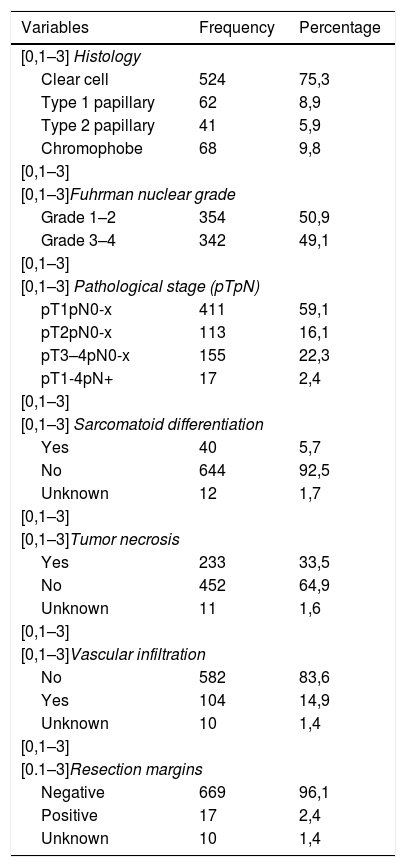There is no consensus on the follow-up protocol after nephrectomy for renal cell carcinoma (RCC), and the identification of recurrence risk groups (RRG) is required.
ObjectiveEstablish recurrence risk groups (RRG).
Material and methodsA retrospective analysis of 696 patients with renal cancer submitted to surgery between 1990 and 2010; 568 (81.6%) patients treated with radical nephrectomy and 128 (18.4%) treated with partial nephrectomy.
Pathological variables were classified as: 1st-level variables (1LPV): pTpN stage and Fuhrman grade (FG); and 2nd level pathological variables (2LPV): sarcomatoid differentiation (SD), tumor necrosis (TN), microvascular invasion (MVI) and positive surgical margins (PSM).
Univariate and multivariate analysis have been performed using Cox regression to determine 1LPV related to recurrence. Based on 1LPV, we classified patients into three RRG: Low (LRG) <25%; Intermediate (IRG) 26–50% and High (HRG) >50%.
We performed univariate and multivariate analysis with the 2LPVs for each RRG. With these data, patients were reclassified as RRG +.
ROC curves were used for comparison of RRG and RRG+.
ResultsThe median follow-up was 105 months (range 63–148). There were 177 (25.4%) patients with recurrence: 111 (15.9%) distant, 34 (4.9%) local and 32 (4.6%) distant and local.
In the multivariable analysis, Fuhrman grade HR = 2,75; p = 0,0001 and pTpN stage HR = 2,19;p = 0,0001 behaved as independent predictive variables of recurrence.
Patients were grouped as RRG AUC = 0,76; p = 0,0001:
- LRG (pT1pNx-0 G1-4; pT2pNx-0 G 1-2 ): 456 (65.5%) patients.
- IRG (pT2pNx-0 G 3-4 ; pT 3-4 pNx-0 G 1-2 ): 110 (15.8%) patients.
- HRG (pT 3-4 pNx-0 G 3-4 ; pT1-4pN+): 130 (18.6%) patients.
After multivariate analysis with 2LPV, RRG were reclassified RRG+ AUC = 0,84, p = 0,0001:
-LRG+ (LRG without TN, SD and/or PSM(+))
-IRG+ (IRG; LRG with TN)
-HRG+ (HRG; LRG with SD and/or PSM(+); IRG with TN and/or SD)
ConclusionThe inclusion of 2LPV to the classification according to VP1N improves the discriminating capacity of RRG classification.
No existe consenso sobre el seguimiento tras nefrectomía por cáncer renal (CCR), siendo necesario establecer grupos de riesgo de recurrencia(GRR).
Material y métodoAnálisis retrospectivo de 696 pacientes con CCR intervenidos entre 1990-2010;568(81.6%)pacientes con nefrectomía radical y 128(18.4%) con nefrectomía parcial.
Se clasificaron las variables patológicas como variables de 1ernivel(VP1N): estadio pTpN y grado de Furhman(GF); y variables patológicas de 2ºnivel(VP2N):diferenciación sarcomatoide(DS),necrosis tumoral(NT), infiltración microvascular(IMV) y márgenes de resección(MR).
Realizamos un análisis multivariante(regresión de Cox) para identificar las variables de 1ernivel relacionadas con la recurrencia. Clasificamos a los pacientes en tres GRR según las VP1N: Bajo(GRB)<25%; Intermedio(GRI) 26-50% y Alto(GRA)>50%.
Tras ello realizamos un análisis univariante y multivariante con las VP2N para cada GRR. Con estos datos se reclasificaron a los pacientes en GRR+.
Para la comparación de los GRR con los GRR + se utilizaron curvas ROC.
ResultadosLa mediana de seguimiento fue de 105(IQR 63-148) meses. Recurrieron 177(25.4%)pacientes: 111(62.7%) pacientes con recidiva a distancia, 34(19.2%) recidiva local y 32(18%) a distancia y local.
Se comportaron como factores predictores independientes de recurrencia el grado de FuhrmanHR = 2,75;p = 0,0001 y el estadio pTpNHR = 2,19;p = 0,0001.
Se agruparon los pacientes en GRR ABC = 0,76;p = 0,0001:
-Grupo de riesgo bajo-GRB(pT1pNx-0 G1-4; pT2pNx-0 G 1-2 ): 456(65.5%)pacientes.
-Grupo de riesgo intermedio-GRI(pT2pNx-0 G 3-4 ; pT 3-4 pNx-0 G 1-2 ): 110(15.8%)pacientes.
-Grupo de riesgo alto-GRA(pT 3-4 pNx-0 G 3-4 ; pT1-4pN+): 130(18.6%)pacientes.
Tras el análisis multivariable con las VP2N, los GRR se reclasificaron GRR+ ABC = 0,84,p = 0,0001:
-GRB+(GRB sin NT,DS y/o MR(+))
-GRI+(GRI; GRB con NT)
-GRA+(GRA; GRB con DS y/o MR(+); GRI con NT y/o DS)
ConclusionesLa adicción de las variables patológicas de segundo nivel a la clasificación según las variables de primer nivel mejora la capacidad de discriminación de la clasificación en GRR.











